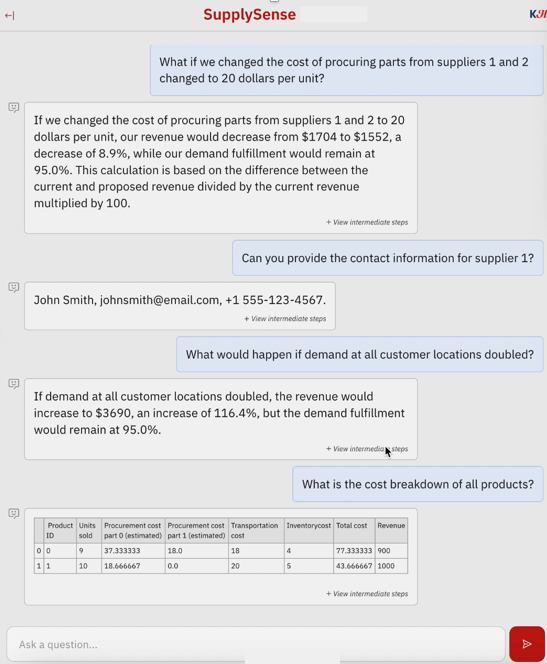
Large language models have taken the world by storm over the last few years. Few domains have been left untouched by this new technology, and mathematical optimization is no exception. LLMs provide an important opportunity as they allow users to interact with optimization models without any technical background, thereby making optimization accessible to more people.
OSI and IBM worked together on a prototype of an application called SupplySense, a S&OP (sales and operations planning) tool powered by decision optimization featuring an intuitive natural language-based user interface.
Why use LLMs to run your optimization model?
In some applications, like production automation, optimization models capture all objectives perfectly, requiring little guidance or input from a human user. In S&OP, however, this is a very different story. S&OP is a long, tedious, and iterative process involving many different stakeholders representing departments like sales, finance, and manufacturing operations. Defining effective S&OP models is challenging for some of the following reasons.
A static optimization model cannot possibly capture every facet of this complex process. It requires iteration with the many stakeholders to help them arrive at a solution that everyone is comfortable with. When it comes to S&OP, the role of an optimization model is not to be a static decision-making engine, but to be a flexible tool for the decision-makers to use after making the necessary modifications on-the-fly without requiring elaborate software development efforts.
Optimization models run on large and complex input data. Usually, testing different S&OP scenarios requires a data analyst with extensive knowledge of the model input data. Fortunately, LLMs have the potential to allow anyone to run new scenarios more quickly and easily using natural language prompts. When multiple decision-makers with different goals and perspectives are in a room together, they can have much more effective working sessions if they can pose their preferences and constraints to the S&OP tool in plain English.
SupplySense
This is why OSI and IBM have partnered on a prototype - SupplySense. SupplySense is powered by a rigorous supply chain optimization model in the backend that can answer questions like.
SupplySense has an intuitive chatbot interface, as seen here. SupplySense will not just return text, but also data tables and visualizations, allowing users to quickly ingest the model output and leverage it to make their best S&OP decisions.

What’s next?
OSI and IBM are currently experimenting with an extension of SupplySense that leverages agentic AI. This AI framework allows the LLM to independently run the model, interpret the results, and then run the model again based on its observation. This update would launch SupplySense from a model interface to an agent that interfaces with the model independently according to its own reasoning.
SupplySense showcases a promising synergy between decision optimization and LLMs. Mathematical optimization is one of the most powerful yet underrated analytical tools, and LLMs can play an important role in helping optimization reach its maximum potential and make the most real-world impact by making it more accessible. Are you interested in learning more about SupplySense, LLMs, or optimization? Please feel free to reach out and our experts will be excited to talk to you.